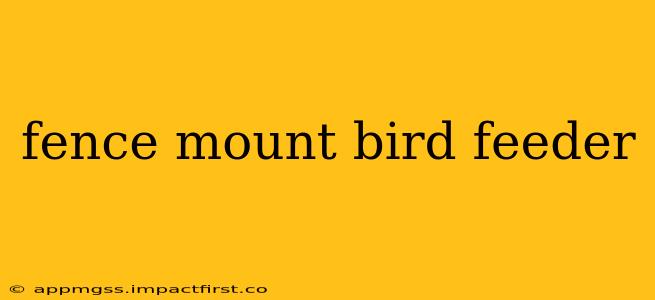Attracting feathered friends to your backyard is a rewarding experience, and a fence mount bird feeder offers a convenient and aesthetically pleasing way to do just that. This comprehensive guide explores everything you need to know about choosing, installing, and maintaining a fence-mounted bird feeder, ensuring a bountiful buffet for your avian visitors.
What are the benefits of a fence mount bird feeder?
Fence mount bird feeders offer several advantages over other styles. They're especially beneficial for those with limited yard space or who prefer to keep feeders away from ground predators like cats and raccoons. The elevated position provides birds with a safe and convenient feeding spot, while also offering you a clear view of your feathered guests. Furthermore, they can be easily moved or repositioned as needed, allowing you to experiment with different locations to find the most popular spot with your local birds.
What types of fence mount bird feeders are available?
The market offers a diverse range of fence mount bird feeders, each with unique features and designs. You'll find variations in:
- Material: Metal feeders are durable and weather-resistant, while plastic options are lightweight and often more affordable. Wood feeders add a rustic charm but require more maintenance to prevent rot.
- Size and Capacity: Consider the number of birds you want to accommodate. Larger feeders hold more seed, requiring less frequent refills.
- Design: From simple single-port feeders to intricate multi-port designs, the choice depends on your aesthetic preferences and the types of birds you want to attract. Some feeders incorporate perches while others encourage birds to cling to the side.
- Seed Type: Some feeders are designed specifically for certain types of birdseed, such as suet, sunflower seeds, or nyjer seed.
How do I choose the right fence mount bird feeder?
Selecting the perfect fence mount bird feeder involves considering several factors:
- Your Fence Type: Ensure the feeder is compatible with your fence material (wood, vinyl, chain link, etc.). Some feeders come with adaptable clamps or brackets.
- Your Budget: Prices vary widely, depending on materials, size, and features.
- Your Birds: Research the types of birds commonly found in your area and choose a feeder that caters to their preferred food and feeding styles.
- Ease of Cleaning: Opt for a feeder with easy access for cleaning, as regular cleaning is crucial to prevent disease.
How do I install a fence mount bird feeder?
Installation is usually straightforward. Most fence mount bird feeders come with instructions and necessary hardware. Generally, you'll need to:
- Choose a suitable location: Select a spot that's sheltered from harsh weather and provides ample visibility for birdwatching.
- Attach the mounting bracket: Securely attach the bracket to your fence using screws or clamps, ensuring it's firmly fixed.
- Hang the feeder: Carefully hang the feeder from the bracket, ensuring it's level and stable.
How do I clean a fence mount bird feeder?
Regular cleaning is essential to prevent the spread of disease among birds. Follow these steps:
- Remove the feeder: Take the feeder down from the fence.
- Empty the feeder: Remove all remaining seed and debris.
- Wash thoroughly: Wash the feeder with warm, soapy water, ensuring you reach all crevices.
- Rinse completely: Rinse the feeder thoroughly to remove all soap residue.
- Dry completely: Allow the feeder to dry completely before refilling.
What kind of birdseed should I use in a fence mount bird feeder?
The best birdseed for your feeder will depend on the birds you wish to attract. Researching the common birds in your region and their preferred foods is key. Popular options include sunflower seeds, nyjer seeds, and suet. Avoid using moldy or spoiled seed.
How often should I refill my fence mount bird feeder?
Refilling frequency depends on the feeder's capacity, the number of birds visiting, and the type of seed you use. Regularly check your feeder and refill as needed to ensure a continuous food supply.
Can I use a fence mount bird feeder in all types of weather?
While many fence mount bird feeders are weather-resistant, extreme weather conditions might require adjustments. In heavy rain or snow, consider providing additional shelter for the feeder or temporarily removing it to prevent seed from becoming soggy or frozen.
By following this guide, you can successfully attract a variety of birds to your backyard with a well-chosen and properly maintained fence mount bird feeder. Remember to prioritize bird safety and hygiene for a rewarding birdwatching experience.
